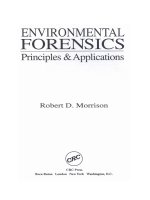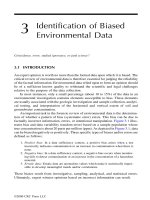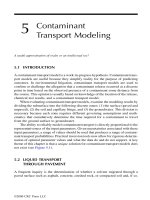Multimedia forensics and securitty foundations innovations and applications
Bạn đang xem bản rút gọn của tài liệu. Xem và tải ngay bản đầy đủ của tài liệu tại đây (14.46 MB, 414 trang )
Intelligent Systems Reference Library 115
Aboul Ella Hassanien
Mohamed Mostafa Fouad
Azizah Abdul Manaf
Mazdak Zamani
Rabiah Ahmad
Janusz Kacprzyk Editors
Multimedia
Forensics
and Security
Foundations, Innovations, and
Applications
Intelligent Systems Reference Library
Volume 115
Series editors
Janusz Kacprzyk, Polish Academy of Sciences, Warsaw, Poland
e-mail:
Lakhmi C. Jain, University of Canberra, Canberra, Australia;
Bournemouth University, UK;
KES International, UK
e-mails: ;
URL: />
About this Series
The aim of this series is to publish a Reference Library, including novel advances
and developments in all aspects of Intelligent Systems in an easily accessible and
well structured form. The series includes reference works, handbooks, compendia,
textbooks, well-structured monographs, dictionaries, and encyclopedias. It contains
well integrated knowledge and current information in the field of Intelligent
Systems. The series covers the theory, applications, and design methods of
Intelligent Systems. Virtually all disciplines such as engineering, computer science,
avionics, business, e-commerce, environment, healthcare, physics and life science
are included.
More information about this series at />
Aboul Ella Hassanien ⋅ Mohamed Mostafa Fouad
Azizah Abdul Manaf ⋅ Mazdak Zamani
Rabiah Ahmad ⋅ Janusz Kacprzyk
Editors
Multimedia Forensics
and Security
Foundations, Innovations, and Applications
123
Editors
Aboul Ella Hassanien
Scientific Research Group in Egypt (SRGE),
Faculty of Computers and Information,
Department of Information Technology
Cairo University
Giza
Egypt
Mohamed Mostafa Fouad
Scientific Research Group in Egypt (SRGE)
Arab Academy for Science, Technology, and
Maritime Transport
Giza
Egypt
Azizah Abdul Manaf
Advanced Informatics School
Universiti Teknologi Malaysia
Kuala Lumpur
Malaysia
Mazdak Zamani
Advanced Informatics School
Universiti Teknologi Malaysia
Kuala Lumpur
Malaysia
Rabiah Ahmad
Universiti Teknikal Malaysia Melaka
(UTem)
Malacca City
Malaysia
Janusz Kacprzyk
Systems Research Institute
Polish Academy of Sciences
Warsaw
Poland
ISSN 1868-4394
ISSN 1868-4408 (electronic)
Intelligent Systems Reference Library
ISBN 978-3-319-44268-6
ISBN 978-3-319-44270-9 (eBook)
DOI 10.1007/978-3-319-44270-9
Library of Congress Control Number: 2016948103
© Springer International Publishing AG 2017
This work is subject to copyright. All rights are reserved by the Publisher, whether the whole or part
of the material is concerned, specifically the rights of translation, reprinting, reuse of illustrations,
recitation, broadcasting, reproduction on microfilms or in any other physical way, and transmission
or information storage and retrieval, electronic adaptation, computer software, or by similar or dissimilar
methodology now known or hereafter developed.
The use of general descriptive names, registered names, trademarks, service marks, etc. in this
publication does not imply, even in the absence of a specific statement, that such names are exempt from
the relevant protective laws and regulations and therefore free for general use.
The publisher, the authors and the editors are safe to assume that the advice and information in this
book are believed to be true and accurate at the date of publication. Neither the publisher nor the
authors or the editors give a warranty, express or implied, with respect to the material contained herein or
for any errors or omissions that may have been made.
Printed on acid-free paper
This Springer imprint is published by Springer Nature
The registered company is Springer International Publishing AG Switzerland
Preface
Digital forensics is the process of uncovering and interpreting electronic data. The
goal of the process is to preserve any evidence in its most original form while
performing a structured investigation by collecting, identifying and validating the
digital information for the purpose of reconstructing past events. However, the
emergence of the cloud computing structures and services, where the information is
stored on anonymous data centers scattered around the world, makes the digital
forensics pose more challenges for law enforcement agencies. Other problems are
the variety formats and the exponential growth of data that need to be analyzed in
reasonable time to conduct a forensics decision.
Although the trust is a fiduciary relationship between the law enforcement
agencies and the cloud service providers, still there is fear that the information on
cloud servers can be altered or hidden without a trace. Agencies are collecting
unencrypted as well as encrypted content. This encrypted content presents another
limitation for forensic investigators.
The objective of this book is to provide the researchers of computer science and
information technology the challenges in the fields of digital forensics, which are
required to achieve necessary knowledge about this emerging field. The book goes
through defining the cloud computing paradigm and its impacts over the digital
forensic science, to the proposal of some authentication and validation approaches.
The book is organized into three parts: Part I introduces the challenges facing the
digital forensics in the new computing paradigm; the cloud computing. This section
provides the characteristics and the limitations attached to the forensic analysis in
such paradigm. Part II focuses on the forensics in multimedia and provides the
application of watermarking as an authentication and validation technique. Finally,
v
vi
Preface
Part III gives a number of recent innovations in the digital forensics field. These
innovations include the data processing, the biometrics evaluations, the cryptography in Internet of Things, and the smart phone forensics.
Giza, Egypt
Giza, Egypt
Kuala Lumpur, Malaysia
Kuala Lumpur, Malaysia
Malacca City, Malaysia
Warsaw, Poland
Aboul Ella Hassanien
Mohamed Mostafa Fouad
Azizah Abdul Manaf
Mazdak Zamani
Rabiah Ahmad
Janusz Kacprzyk
Contents
Part I
Forensic Analysis in Cloud Computing
Cloud Computing Forensic Analysis: Trends and Challenges . . . . . . . . .
Amira Sayed A. Aziz, Mohamed Mostafa Fouad and Aboul Ella Hassanien
3
Data Storage Security Service in Cloud Computing:
Challenges and Solutions . . . . . . . . . . . . . . . . . . . . . . . . . . . . . . . . . . . . . .
Alshaimaa Abo-alian, Nagwa L. Badr and Mohamed Fahmy Tolba
25
Homomorphic Cryptosystems for Securing Data in Public
Cloud Computing . . . . . . . . . . . . . . . . . . . . . . . . . . . . . . . . . . . . . . . . . . . .
Nihel Msilini, Lamri Laouamer, Bechir Alaya and Chaffa Hamrouni
59
An Enhanced Cloud Based View Materialization Approach
for Peer-to-Peer Architecture . . . . . . . . . . . . . . . . . . . . . . . . . . . . . . . . . . .
M.E. Megahed, Rasha M. Ismail, Nagwa L. Badr
and Mohamed Fahmy Tolba
Distributed Database System (DSS) Design Over a Cloud
Environment . . . . . . . . . . . . . . . . . . . . . . . . . . . . . . . . . . . . . . . . . . . . . . . .
Ahmed E. Abdel Raouf, Nagwa L. Badr and Mohamed Fahmy Tolba
77
97
A New Stemming Algorithm for Efficient Information Retrieval
Systems and Web Search Engines . . . . . . . . . . . . . . . . . . . . . . . . . . . . . . . 117
Safaa I. Hajeer, Rasha M. Ismail, Nagwa L. Badr
and Mohamed Fahmy Tolba
Part II
Forensics Multimedia and Watermarking Techniques
Face Recognition via Taxonomy of Illumination Normalization . . . . . . . 139
Sasan Karamizadeh, Shahidan M. Abdullah, Mazdak Zamani, Jafar Shayan
and Parham Nooralishahi
Detecting Significant Changes in Image Sequences . . . . . . . . . . . . . . . . . . 161
Sergii Mashtalir and Olena Mikhnova
vii
viii
Contents
VW16E: A Robust Video Watermarking Technique Using
Simulated Blocks . . . . . . . . . . . . . . . . . . . . . . . . . . . . . . . . . . . . . . . . . . . . . 193
Farnaz Arab and Mazdak Zamani
A Robust and Computationally Efficient Digital Watermarking
Technique Using Inter Block Pixel Differencing . . . . . . . . . . . . . . . . . . . . 223
Shabir A. Parah, Javaid A. Sheikh, Nazir A. Loan and G.M. Bhat
JPEG2000 Compatible Layered Block Cipher . . . . . . . . . . . . . . . . . . . . . 253
Qurban A. Memon
Part III
Digital Forensic Applications
Data Streams Processing Techniques . . . . . . . . . . . . . . . . . . . . . . . . . . . . . 279
Fatma Mohamed, Rasha M. Ismail, Nagwa L. Badr
and Mohamed Fahmy Tolba
Evidence Evaluation of Gait Biometrics for Forensic Investigation. . . . . 307
Imed Bouchrika
Formal Acceptability of Digital Evidence . . . . . . . . . . . . . . . . . . . . . . . . . 327
Jasmin Cosic
A Comprehensive Android Evidence Acquisition Framework . . . . . . . . . 349
Amir Sadeghian and Mazdak Zamani
A New Hybrid Cryptosystem for Internet of Things Applications . . . . . 365
Ashraf Darwish, Maged M. El-Gendy and Aboul Ella Hassanien
A Practical Procedure for Collecting More Volatile Information
in Live Investigation of Botnet Attack . . . . . . . . . . . . . . . . . . . . . . . . . . . . 381
Yashar Javadianasl, Azizah Abd Manaf and Mazdak Zamani
Contributors
Ahmed E. Abdel Raouf Faculty of Computer and Information Sciences, Ain
Shams University, Cairo, Egypt
Shahidan M. Abdullah Advanced Informatics School (AIS), Universiti Teknologi Malayisa, Kuala Lumpur, Malaysia
Alshaimaa Abo-alian Faculty of Computer and Information Sciences, Ain Shams
University, Cairo, Egypt
Bechir Alaya Department of Management Information Systems, CBE Qassim
University, Buraidah, Saudi Arabia; Higher Institute of Technological Studies,
University of Gabes, Gabes, Tunisia
Farnaz Arab Kean University, Union, NJ, USA
Amira Sayed A. Aziz Université Française d’Egypte, Cairo, Egypt
Nagwa L. Badr Faculty of Computer and Information Sciences, Ain Shams
University, Cairo, Egypt
G.M. Bhat Department of Electronics and Instrumentation Technology, University of Kashmir, Srinagar, India
Imed Bouchrika Faculty of Science and Technology, University of Souk Ahras,
Souk Ahras, Algeria
Jasmin Cosic Ministry of Interior, University of Bihac, Bihac, Bosnia and
Herzegovina
Ashraf Darwish Faculty of Science, Computer Science Department, Helwan
University, Cairo, Egypt
Maged M. El-Gendy Faculty of Science, Computer Science Department, Helwan
University, Cairo, Egypt
ix
x
Contributors
Mohamed Mostafa Fouad Arab Academy for Science, Technology, and
Maritime Transport, Cairo, Egypt
Safaa I. Hajeer Ain Shams University, Cairo, Egypt
Chaffa Hamrouni LITIS-Lab, University of Le Havre, UFR Sciences et
Techniques, Le Havre Cedex, France; MAC’S-Lab, National Engineering School of
Gabes, Zerig, Gabes, Tunisia
Aboul Ella Hassanien Faculty of Computers and Information, Cairo University,
Cairo, Egypt
Rasha M. Ismail Ain Shams University, Cairo, Egypt
Yashar Javadianasl AIS, UTM, Kuala Lumpur, Malaysia
Sasan Karamizadeh Advanced Informatics School (AIS), Universiti Teknologi
Malayisa, Kuala Lumpur, Malaysia
Lamri Laouamer Department of Management Information Systems, CBE Qassim
University, Buraidah, Saudi Arabia; Lab-STICC (UMR CNRS 6285), University of
Western Brittany, Brest Cedex, France
Nazir A. Loan Department of Electronics and Instrumentation Technology,
University of Kashmir, Srinagar, India
Azizah Abd Manaf AIS, UTM, Kuala Lumpur, Malaysia
Sergii Mashtalir Kharkiv National University of Radio Electronics, Kharkiv,
Ukraine
M.E. Megahed Faculty of Computer and Information Sciences, Ain Shams
University, Cairo, Egypt
Qurban A. Memon UAE University, Al-Ain, United Arab Emirates
Olena Mikhnova Kharkiv Petro Vasylenko National Technical University of
Agriculture, Kharkiv, Ukraine
Fatma Mohamed Faculty of Computer and Information Sciences, Ain Shams
University, Cairo, Egypt
Nihel Msilini MAC’S, National Engineering School of Gabes, University of
Gabes, Zerig, Gabes, Tunisia
Parham Nooralishahi Department of Computer Science and Information
Technology, University of Malaya, Kuala Lumpur, Malaysia
Shabir A. Parah Department of Electronics and Instrumentation Technology,
University of Kashmir, Srinagar, India
Amir Sadeghian Advanced Informatics School, Universiti Teknologi Malaysia,
Kuala Lumpur, Malaysia
Contributors
xi
Jafar Shayan Advanced Informatics School (AIS), Universiti Teknologi Malayisa,
Kuala Lumpur, Malaysia
Javaid A. Sheikh Department of Electronics and Instrumentation Technology,
University of Kashmir, Srinagar, India
Mohamed Fahmy Tolba Faculty of Computer and Information Sciences, Ain
Shams University, Cairo, Egypt
Mazdak Zamani Department of Computer Science, Kean University, Union, NJ,
USA
Part I
Forensic Analysis in Cloud Computing
Cloud Computing Forensic Analysis:
Trends and Challenges
Amira Sayed A. Aziz, Mohamed Mostafa Fouad
and Aboul Ella Hassanien
Abstract Computer forensics is a very important field of computer science in
relation to computer, mobile and Internet related crimes. The main role of Computer
forensic is to perform crime investigation through analyzing any evidence found in
digital formats. The massive number of cybercrimes reported recently, raises the
importance of developing specialized forensic tools for collecting and studying
digital evidences in the digital world, in some situation even before they are lost or
deleted. The emergence of the new Cloud Computing paradigm with its unique
structures and various service models, had added more challenge to digital forensic
investigators to gain the full access and control to the spread cloud resources.
While, the current chapter starts to lay the importance of digital forensics as whole,
it specially focuses on their role in cybercrimes investigations in the digital cloud.
Therefore, the chapter goes through the definition of the basic concepts, structures,
and service models of the cloud computing paradigm. Then, it describes the main
advantages, disadvantages, challenges that face the digital forensic processes, and
techniques that support the isolation and preservation of any digital evidences.
Finally, the chapter stresses on a number of challenges in the cloud forensic analysis
still open for future research.
Scientific Research Group in Egypt (SRGE).
A.S.A. Aziz (✉)
Université Française d’Egypte, Cairo, Egypt
e-mail:
URL:
M.M. Fouad
Arab Academy for Science, Technology, and Maritime Transport, Cairo, Egypt
A.E. Hassanien
Faculty of Computers and Information, Cairo University, Cairo, Egypt
© Springer International Publishing AG 2017
A.E. Hassanien et al. (eds.), Multimedia Forensics and Security,
Intelligent Systems Reference Library 115, DOI 10.1007/978-3-319-44270-9_1
3
4
A.S.A. Aziz et al.
1 Introduction
The Cloud Computing, is one of the fastest growing technologies that attracts
researchers to add and improve its services [1, 2]. Organizations benefit from this
technology by replacing traditional IT hardware and data centers with remote,
on-demand paid hardware and software services that are configured for their particular needs, managed and hosted by the organization users or even a third party.
This increases the organization’s flexibility and efficiency, without the need to have
a dedicated IT staff or owning special hardware equipment or software licenses.
However, cloud computing security is still an open research issue, and malicious
users take advantage of this lack of advanced security mechanisms. According to a
Forbes magazine report in 2015 [3], “The cybersecurity space is arguably the
hottest and fastest growing tech sector.” The worldwide cybersecurity market
estimates a range from $77 billion in 2015 to $170 billion by 2020. In the Guardian
[4], they stated that “The sharp rise in the headline figures is due to the inclusion of
an estimated 5.1 million online fraud incidents and 2.5 million cybercrime offences
for the first time.” The statistics of 2015 stated in Hackmageddon [5]—an Information Security Timelines and Statistics website—shows that 2015 has reported a
more sustained activity in cybercrime. Figure 1 [5] shows that cybercrime is the
major motivations behind attacks and intrusions, it even increased compared to year
2014.
Figure 2 shows the targeted sectors by cybercrime and attacks, while Fig. 3
shows different attack techniques followed by criminals in 2015 versus 2014 [5].
Based on previous statistics, it becomes a necessity to conduct a digital forensic
investigations once an attack takes place. Computer forensics has emerged to assist
Fig. 1 Motivation behind online attacks [5]
Cloud Computing Forensic Analysis: Trends and Challenges
5
Fig. 2 Targeted sectors by cybercrime [5]
Fig. 3 Attack techniques [5]
law enforcement and provide them with means to investigate cybercrimes and
online attacks through the digital world. Live digital forensic is required to be able
to collect and analyze evidences before they are lost or deleted. Investigators need
more tools to help them conduct digital forensics in the cloud [6].
This chapter provides a quick review of basic cloud computing concepts and
structures. Then, it describes the general model of digital forensic process. Finally,
the chapter goes through the analysis process in the cloud environment, along with
current challenges and open research topics.
6
A.S.A. Aziz et al.
2 Cloud Computing Environment
Cloud is a buzzword that reflects the floating of uncontrolled and unstructured
density of mist high above the general level of human touch. The term has the same
metaphor in computer science since it means the data are saved somewhere, through
the internet and the user can access it any time through using any internet enabling
device. Since the cloud not only provides a storage resources but also provide
computation over the internet, users often entitled it the “Cloud Computing”. The
real emergence of the cloud computing had started through the appearance of the
Application Service Providers (ASP) companies. For a predefined paid fees, these
companies rent their computational capabilities to run customers’ applications [7].
The ASP companies are responsible for all the infrastructure, including hardware,
software, updates, and scalability management, on behalf of their customers.
Therefore, the cloud computing had removed the fear of hardware scalabilities,
hiring or training new employees, and purchasing software licenses.
The advances in cloud computing technologies have made several organizations
rethink to move their business to the cloud. A great number of businesses had
already shifted away from legacy IT services to cloud-based services paradigm;
according to Gartner, the worldwide public cloud services market is projected to
grow 16.5 % in 2016 to total $204 billion, up from $175 billion in 2015 [8]. In
addition to the business shift to the cloud, the emergence of smartphone devices,
had arisen a new dimension of cloud computing; where instead of utilize native
mobile applications (mobile apps), those downloaded, installed and run over a
particular mobile platforms, the users had rapidly diverted to utilize mobile cloud
apps [9]. These cloud-based mobile apps facilitated the developer mission that
instead of developing different versions of the same application to fit different
platforms (IOS, Android, or Windows), he develops only one single version of the
application over the cloud, then through a browser or a mobile API, it can be used.
According to Cisco Visual Networking Index the cloud apps will comprise 90 % of
total mobile data traffic by 2019 [10]. Figure 4 shows a forecast of a compound
annual growth rate (CAGR) of 60 % of mobile cloud traffic [11].
Fig. 4 Mobile cloud traffic forecasting from 2014 till 2019 [11]
Cloud Computing Forensic Analysis: Trends and Challenges
2.1
7
The Cloud Models
The cloud models can be differentiated based on general features such as the level
of security, control, and cost effectiveness [12]. The cloud model is either private,
public, or hybrid.
Public Cloud Model: is where the infrastructure is made available for multiple
customers. The owner of the cloud is either a single or multiple organizations. The
main feature of that cloud model is its cost effectiveness to customers. Customers
are only paying for the resources they acquired. The location independence and
flexibility to access the cloud from any internet enabled device are other added
values to the spreading of the public cloud. Microsoft, Google and Amazon are of
the big companies offering their infrastructure to public customers.
Private Cloud Model: provides a shared pool of resources and services under the
control of a single organization. The customer of the private cloud could be the
same organization or a third party. Private clouds offer a great security and privacy
at greater cost such as the NIRIX’s oneServer [13] which provides a dedicated
servers to host e-commerce applications, websites, or web-based business applications for either internal or external access. In brief, while private clouds offer a
best suitable solution to securing critical data, investment in configuring and
maintaining private clouds is more expensive than public clouds. In addition, the
scalability of the private clouds is constrained to the acquired resources.
Hybrid cloud model gets the best of both public and private models (Fig. 5). It is
considered a good business strategy to cut down the cost through utilizing the
public clouds for some applications while maintaining the private data over their
private cloud. The integration of both clouds is a major concern since it requires a
strict security requirements to control which information should flow to the public
cloud.
Public
Cloud
Private
Cloud
Hybrid
Cloud
Fig. 5 Basic cloud computing models
8
2.2
A.S.A. Aziz et al.
The Cloud Structure and Services
Cloud structure is composed of building blocks (layers). The perception of the
cloud structure is based on either the cloud functionality, or on the resources it
offered.
Based on the cloud functionality, the cloud structure composed of four layers,
each layer providing a distinct level of functionality. According to [14] the layers
are: hardware components (datacenters), infrastructure, platform, and application
(API) layer. Each layer is served by the layer below and it serves the above layer.
The hardware components layer is referred as datacenters layer since it is the
base layer that including all hardware components that usually exist in the datacenters including: servers, storage mediums, communication devices, and power
resources.
The Infrastructure layer is the dynamic assignment layer that uses virtualization
management principles to partitioning the hardware resources among the customers. The Linux-VServer [15], and VMware [16] are widely applied virtualization software to partitioning a server into multiple logical servers that can run
independently for different operating systems and applications.
The platform layer is the attached layer to the infrastructure layer which provides
flexibility to developers to use the existing API to implement and deploy their
applications over the cloud. Hence, there is no need for the developer to deal with
the operating system that installed within the logical server; e.g. the App Engine of
Google Inc. [17] allows developers to easily build web and mobile backends
applications over the Google’s cloud with the advantage of automatic scalability of
hosted applications based on the usage traffic.
The application layer is the most visible layer for the end user at which he uses
the service or the application provided by the cloud. Usually, the provided services
are not free of charge; such as Alexa [18] that provides analytical digital tools for
ranking websites based on analyzing their usage traffic for other organizations.
The next perception for cloud’s layers is to define them by the resources the
Cloud Service Provider (CSP) offered (service models): Infrastructure as a Service
(IaaS), Platform as a Service (PaaS), and Software as a Service (SaaS).
The Infrastructure as a Service (IaaS) represents the low-level abstraction of
cloud’s physical devices (servers, storage, or networking capabilities) those to be
offered to the cloud’s customers on their demand. Therefore, customers can use the
virtualization to create logical servers and even connect them to other logical servers instead of purchasing real servers. The fees are to be considered according to
the resources to be consumed.
The Platform as a Service (PaaS) is the management environment that provided
by the CSP to rapidly create and deploy applications. The traditional application
development becomes complex since the company purchase and setup hardware,
software, and required in-house configuration. The PaaS removed that development
hassle through “just-log-in-and-get-to-work” principle. The Salesforce.com [19]
provides a PaaS solution for Customer Relationship Management (CRM) products.
Cloud Computing Forensic Analysis: Trends and Challenges
9
The solution allows non-technical customers to effectively customize functions that
exist across their businesses.
Finally, the Software as a Service (SaaS) is the most accessible layer of the cloud
that represents the provision of actual applications or services to the end users. The
providers of SaaS should keep running and adapting the increasing number of
customers and applications over their cloud. As to imagine the problem that faces
those providers, the Statista portal [20] had reported that the Google Play had
passed over 1.8 million in last quarter of 2015 apps while Apple iTune had
exceeded from 800 apps in July 2008, the month of its launch, to 1.5 million in June
2015.
3 Digital Forensics
Digital Forensics is defined as “the use of scientifically derived and proven methods
toward the preservation, collection, validation, identification, analysis, interpretation, documentation and presentation of digital evidence derived from digital
sources for the purpose of facilitation or furthering the reconstruction of events
found to be criminal, or helping to anticipate unauthorized actions shown to be
disruptive to planned operations” [21]. Digital forensics is a discipline where law
and computer science are combined to collect and analyze data from computers,
networks, and storage devices where there is an evidence that would be admissible
in a court of law [1, 22].
In the past, digital forensic services were used only in late stages of an investigation, where digital evidence might have been damaged or spoiled. Now, it has
become and essential right at the beginnings of all investigation types. Digital
forensics emerged out of practitioners’ community, where investigators and
developers unify their efforts to find solutions to real-world problems. The first
Digital Forensic Research Workshop (DFRWS) was held in 2001 to construct a
community that applies scientific method to find solutions driven by practitioners’
requirements and needs. Different organizations have contributed to establish an
academic and scientific basis for the Digital Forensic research. The Scientific
Working Group on Digital Evidence (SWGDE) released many documents concerning standards, best practices, validation processes. The US National Institute of
Standards and Technology (NIST) started the Computer Forensic Tool Testing
(CFTT) Project in 2001 that has established and executed protocols for digital
forensic tools [23, 24].
Physical media, operating system, file system, and user-level applications produce artifacts where digital evidence is created and left behind. They are used by
investigators to extract information that would help them understand the past
behavior in the digital environment. Relatively, most digital forensics research has
focused on where artifacts exist and why, and how to recover them. Two research
areas have gone through notable growth: Data Carving and Memory Analysis,
which contribute more to the forensic analysis phase. At the same time, the
10
A.S.A. Aziz et al.
response and data collection phases were still away from attention and have
unanswered questions, as more priority is given to the analysis [23, 25].
Two categories of digital forensics exist: Static Forensics and Live Forensics.
Static Forensics is offline forensics where analysis is performed on data acquired
from storage devices and hard drives obtained using traditional formalized procedures. Live Forensics is where analysis of any relevant data is done while the
system being analyzed is running [22].
Certain issues may face the digital forensic process, according to the service
model provided by the cloud [26]:
• SaaS Model Environment—As it was previously described in Sect. 2, the
customer does not have any control over the platform, the infrastructure, or the
operating system in such environment. Only control over some application settings may be granted, therefore, they do not have any chance of analyzing
possible incidents. The CSP merely is the main source of data investigation, even
with the availability of log information. The situation might be better in the SaaS
over the private cloud, where the customer and the CSP belong to the same entity.
• PaaS Model Environment—there is a main advantage in this model, where the
customer has full control over running applications, which means that logging
mechanisms can be deployed to gather information and transfer it to a third party
or locally analyzed. However still, CSP has to do necessary configuration to
control the underlying runtime environment—hence, give the ability to developers collect some diagnostic data.
• IaaS Model Environment—in this model the customer has the full control to
install and set up images for forensic purposes. Snapshots of virtual machines
can be employed, to provide data for the investigation process, a snapshot clones
the virtual machine by one click, including the system’s memory. Also, the
system itself can be prepared for forensic investigation purposes logging lively
continuous information of users, open ports, running processes, registry information, and other forensic analysis processes.
3.1
Digital Forensics Common Phases
Four principles of digital forensic practice were proposed by the Association of
Chief Police Officers, and these are [6]:
1. Data extracted or held on a computer or any storage media should not be
changed or modified by any action taken by the investigators, so that the evidence would remain reliable in court.
2. An expert and dependent person should be in charge of accessing original data
on computer or storage media if needed, so that person would be qualified to do
so and be able to explain their relevance and implications in the investigated
case.
Cloud Computing Forensic Analysis: Trends and Challenges
Fig. 6 Digital forensic
process model
11
Pre-Process
IdenƟficaƟon
AcquisiƟon & PreservaƟon
CollecƟng
TransporƟng
Storing
Preserving
Analysis & ExaminaƟon
PresentaƟon
DocumentaƟon
ReporƟng
Post-Process
3. It should be available to create and preserve audit trails and records of all
procedures and processes applied to digital evidence so that if an independent
party examined these processes, they should achieve the same results.
4. A case officer is assigned to the investigation to hold the overall responsibility
for ensuring that law and legal principles are applied as followed.
The primary model of digital forensics stated in 1984 that it consists of four
phases that were presented by Pollitt in [27, 28]: Acquisition, Identification,
Evaluation, and Admission, as shown in Fig. 6. Through the beginning of 2000s
some phases were added to the model or changed, where additional steps were
needed to be added to the main process through the development of the digital
forensics. The additional phases included: Preservation, Collection, Examination,
Analysis, and Presentation. Considerable research adapted specific conception of
the model, where some added a Traceback phase where investigators are able to
trace back all the way to the actual devices used by the criminals [29]. Others added
a Planning phase to ensure the success of the investigation; this was in Extended
Model of Cybercrime Investigation (EMCI) [30], Computer Forensic Field Triage
Process Model (CFFTPM) [31], and Digital Forensic Model based on Malaysian
Investigation Process DFMMIP [32], to improve the investigation process by prior
planning of all the phases to follow. Furthermore, others added a Proof and Defense
phase (in EMCI [30] and DFMMIP [31]). In previous phase, the investigators are
required to present proof for the used evidence in the investigation, to support the
presented case.
12
A.S.A. Aziz et al.
The Generic Computer Forensic Investigation Model (GCFIM) was proposed as
a general model of the digital investigation process, where recommended phases in
other models can be placed in at least one of the stated phases in that model—as
stated in the figure below [33].
The Pre-Processing phase is related to obtaining forensic data and requesting for
forensics by getting the necessary approval from relevant authority and setting up
the tools to be used. The Post-Process phase involves the return of physical and
digital evidence to their rightful owners or kept in safe place if necessary.
The phases of the digital forensic analysis goes as follows [1, 2, 6].
3.1.1
Identification
First, there should be a declaration of a potential committed crime or improper act
that has taken place in the system. Identification of such crime may be a result of
profile detection, audit analysis, complaints by some individuals, or detected
anomalies—especially in a repetitive manner—and so on. This phase may not only
be concerned with digital forensics, but it has a big impact on how the investigation
is conducted and defining the purpose of such investigation.
3.1.2
Acquisition and Preservation
Relevant data to the identified crime or illegal act should be collected and preserved
so that it will not be lost, manipulated, or modified in anyway. Specialized tools
should be used and approved methods should be followed in this phase such as the
Forensic Explorer (FEX) software [34]. A challenging topic for investigators is the
massive amount of data that they might have to collect and deal with. Investigators
should also keep a roadmap or a registry of evidence was collected, analyzed, and
reserved for the presentation in court—which is called Chain of Custody. This
provides a proper documentation of how evidence was gathered and handled, by
whom and when. The preservation is concerned with keeping a timeline of the
collected evidences to be able later to create the sequence of events involved in the
attack. This can be done by collecting timing information from timestamps in
meta-data or different log files of applications and networks.
3.1.3
Analysis
Once data has been collected and preserved, they should go through examination
and analysis to extract important patterns required by investigation process out of
the collected data. Many software tools, such as Digital Forensics Framework [35],
Open Computer Forensics Architecture [36] and EnCase [37] are used by an
Cloud Computing Forensic Analysis: Trends and Challenges
13
investigator for pattern matching, filtering, searching, discovering attempts to delete
data, or recover lost data. During the analysis phase, a scenario is developed based
on the evidence and their timeline to explain how a crime was committed. If
possible, certain users or user account might be associated with certain evidence or
event. Evidences also should be subjected to validation to assure they have not been
altered or manipulated before the examination phase.
3.1.4
Presentation
Finally, reports should be prepared, in order to summarize the conclusions and to
provide explanations for these conclusions through evidence collection and
examination. Then, these reports are submitted to court of law, and the investigator
would be subject to expert testimony and cross-validation.
3.2
Digital Evidence
The National Institute of Justice defined a digital evidence as any data or information that is of value to an ongoing investigation, and that is stored on, received,
or transmitted by an electronic device. A digital evidence can be found on the
Internet, on stand-alone computers, or on mobile phones. The Internet offers global
access to information and computers, which gives the criminals the ability to access
different information sources, banks, governmental networks, and other systems
they could sabotage. The communication activities with time stamps and traces left
on accessed computers can be used as digital evidence for investigations of digital
crimes. Also, any stored data on computers can be used as digital evidence, where
they are located on the physical hard drive and removable media. For mobile
phones, their tracking capability would turn the mobile phones into key evidence in
many cases [6, 38].
The data to be collected and acquired may be available in three different statuses
[26]. Figure 7 illustrates these statuses. Data at rest means they stored in a database
or a specific file format, allocated in disk space. Data in motion refers to data that
transferred between entities. Data in execution is data loaded into memory and
executed as a process. For each state, different techniques are applied to acquire the
data. Data at rest can be extracted by investigators from hard disks, even if they are
deleted—as long as they are not de-allocated, they can be retrieved by some
software applications. Data in motion usually leave traces on systems and network
devices through protocols applied for data transfer on networks. Hence, these traces
can be collected and used by the investigators. For data in execution, snapshot
technology can be used, where process information, machine instruction, and
memory data can be analyzed.
14
A.S.A. Aziz et al.
Fig. 7 Data acquired statuses
Data in MoƟon
Data in ExecuƟon
Data
Data in Rest
Hence, there are three possible sources of data to be collected as artifacts and
used later as evidence: Virtual Cloud Instance, Network Layer, and Client System
[26]. A Virtual Cloud Instance is where an incident took place, hence it can be a
potential starting point or an investigation. Based on the type of service the client is
using (IaaS, SaaS, or PaaS), instance can be accessed by the CSP only or also
through the customer. Snapshots are powerful tool a customer can use to save
specific states of the virtual machine. Network Layer (and other ISO/OSI layers)
can provide different information on communication between instances inside and
outside the cloud. Unfortunately there is a problem of the log data that can be
provided by the CSP for investigations in the case of an incident, which is
explained later in challenges. The Client System, it completely depends on the
service used to whether any data can be provided or not. In most cases, the browser
provides a source of data since it is the application used to connect clients to the
cloud services.
Pre- and post-crime information might be used as crime evidence, especially if
the crime was completely committed through digital means. In digital world, there
is always an electronic trail of activities and information left behind to be seized and
exploited. The most important thing for investigators is to follow proper procedures
so that evidences would not be lost, damaged, or manipulated that it will not be
admissible in courts of law.
A digital evidence should fulfill some characteristics to be legally considered in
an investigation [39]:
• Authentic—original and related to the investigated crime.
• Reliable—collected using reliable procedures that if it run by an independent
party would give the same results.
• Complete—neither corrupted nor manipulated.
• Believable—convincing and making sense to an ordinary juries.
• Admissible—collected using common law procedures, following agreeable
policies.









